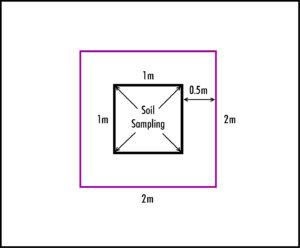Final report for FNC20-1208
Project Information
Field and Forest Products grows mushrooms commercially for farm markets and co-op accounts and has also been producing mushroom spawn and providing growing supplies to commercial cultivators and hobby growers for over 30 years. Field and Forest Products also supports its farmer customers by answering grower questions about how to grow specialty mushrooms profitably. The 41 acre farm grows and markets Shiitake and Wine cap as well as other specialty fungi, with special attention to polyculturing Wine cap and Almond Agaricus in the garden and high tunnel setting. Field and Forest Products Inc. is co-owned and operated by Mary Ellen Kozak and Joe Krawczyk. The couple are authors of several mushroom cultivation related publications, most notably, Growing Shiitake in a Continental Climate. Field and Forest Products recently teamed up with mycologist Lindsey Bender who specializes in soil microbial ecology, experimental design, and statistics. She comes from a diverse ecological background and has a strong interest in research and development focusing on sustainable practices and improving soil health.
The farm operates on a foundation of sustainable-focused practices. We strive to reuse and recycle as many resources as possible including, but not limited to: water, food scraps, paper materials, packaging materials, and other wastes generated by the business and farm operation. We participate in outdoor composting and indoor vermicomposting, utilize paper materials and other waste products as substrate for mushroom cultivation, heat our facility with sustainably harvested on-site firewood and exhausted shiitake logs, recycle gray water, reduce printing, and many more. The nature of fungi as environmental recyclers enhances our abilities as a company to operate as sustainably as we can.
Soil health is critical to sustainable agriculture and nutrient dense food production. Many agricultural soils are unhealthy and standard practices like tilling, fertilizing, soil compaction, and over production, are exacerbating the problem. In order to improve the health and potential of our soils to ensure our future food demands are met, we need to make sustainable changes. This project proposes to evaluate the use of an innovative method for soil improvement while increasing crop productivity, food nutritive value, and income revenue for farmers. The use of the Wine Cap mushroom as a soil builder shows promise from previous research. New research in nutrition indicates that mushrooms contain Ergothioneine, an important antioxidant linked to longevity and healthy aging. While mushrooms are the primary source of Ergothioneine, evidence suggests plants grown in healthy soils or alongside fungi have increased Ergothioneine concentrations. Wine Cap (Stropharia rugoso-annulata) is simple to grow, highly productive, and has significant potential for farmer crop diversification. This study is a collaborative effort between experienced mushroom farmers, University researchers, and the agricultural community. This project will provide quantitative data and a project-based avenue for educating farmers about the benefits and ease of mushroom cultivation, while evaluating the application of mushroom growing to improve soils and plant crops.
The research approach for this project included extensive literature search and design and carry out of a scientific evaluation of our hypotheses. We designed and executed an experimental plot with three treatments (Control, Straw mulch, and Straw mulch with the Wine Cap mushroom) with 5 replicates in a randomized block design. We collected quantitative and qualitative data on over 30 variables, performed regular assessments, and sent in samples for further testing. Due to the COVID pandemic, we had to modify our plans to host onsite workshops for outreach and dissemination, and instead, focused on creating video, newsletter, and social media content to promote this project and reach farmers.
Project Conclusions
Over the three years of this study, we were able to confirm the findings of our previous grant FNC17-1070. We consistently measured larger, healthier crop plants (Tomato, corn, and black bean) grown in plots with the commonly cultivated Wine Cap Mushroom (Stropharia rugoso-annulata). Furthermore, tomato plants grown in plots with Wine Cap had higher yields, on average, than the straw and control plots. The addition of mulch to the soil surface can increase soil moisture retention, aid in building the soil, suppress weeds, and act as a protectant from soil-borne pathogens for plants. We were able to measure these benefits by comparing control plots to the treatment plots that received mulch. Furthermore, we were able to demonstrate that the addition of Wine Cap not only speeds up the decomposition of raw organic mulch materials, but the actively growing fungi also increase bed temperature. We continued to struggle with how to appropriately measure any soil changes in response to our treatments. Given the high degree of spatial-temporal variation in many soils, we increased our number of replicates as well as number of soil cores per plot from the previous study. Despite these attempts, there was still a high degree of variability between our 5 replicate plots in each treatment. It is possible that the time frame of this study is insufficient to measure changes in soil parameters. Lastly, 2022 was a much drier season than 2020 and this likely attributed to the significant decline in overall soil biological activity from 2020 to 2022.
These results, our experimental work, and experiences have been frequently shared through the Field and Forest website, video content, and direct communications with farmers. We have noticed a significant increase in farmer interest in using cultivated fungi to improve soil health and many who have shared their own experiences and observations.
This project seeks to evaluate the use of the low cost, organically grown Wine Cap mushrooms to improve soil health, reduce the need for tilling, weed control, and watering while increasing crop health, productivity, and value (increased through increased nutrient density and Ergothioneine content.
Our objective are:
- Test changes in soil health in response to Wine Cap mushroom cultivation through field testing
- Involve and educate farmers to promote mushroom industry growth through field days, social media, and consulting
- Measure Ergothioneine content in response to Wine Cap
We designed an experimental plot with three treatments and five replicates in a random block design on our farm in Peshtigo, WI. We took baseline soil measurements in 2020 when the plots were established, and then again at the end of the 2022 season in order to measure any changes over the experimental period. We planted several crop plants in the three years of the study (tomato, corn, black beans) in order to measure treatment effects on plant health and productivity. Plant samples (roots, leaves, fruits) were harvested and stored for further testing including ergothioneine content.
Research
Establish 15 individual plots total in spring 2020 (3 treatments (control, mulch only, mulch with Wine Cap x 5 replicates), 2m x 2m in size with 2m rows between plots. Preliminary baseline soil samples were taken from the center 1.0m2 area of each plot (to limit edge effects) to a depth of 10cm. A minimum of 10 cores/plot were harvested, homogenized, then sent off for testing. Treatments were planted using straw only based on previous grant results indicating straw beds were healthier and more productive. Straw was soaked, drained, and layered with Wine Cap in treatment plots. Mulch only treatment plots were planted with just straw. Control plots plants only, no mulch. We monitored plots biweekly as described above and data was collected throughout the first growing season.
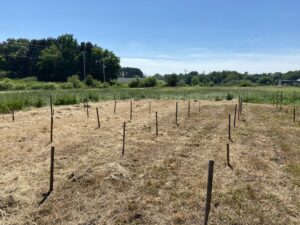
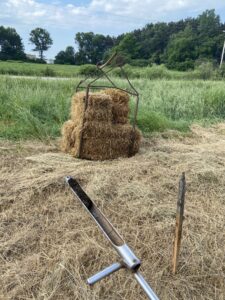
Soil sampling diagram.
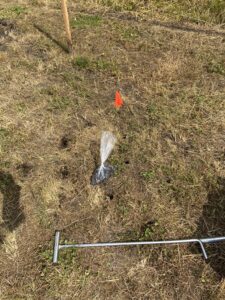
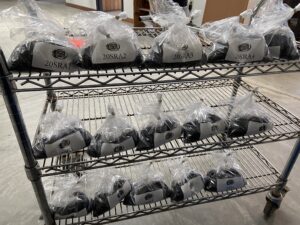
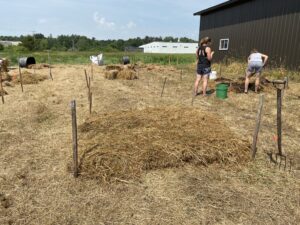
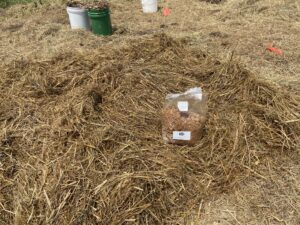
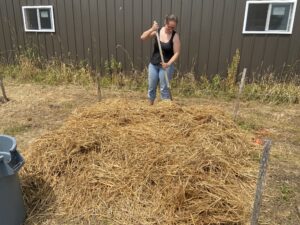

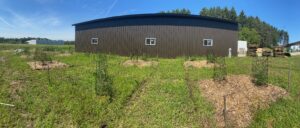
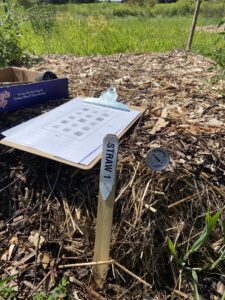
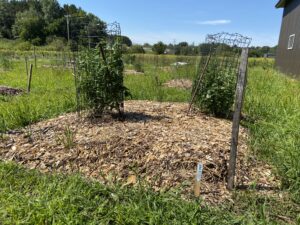
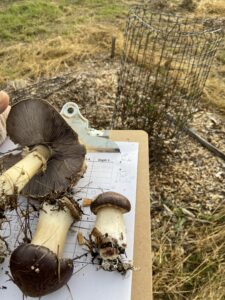
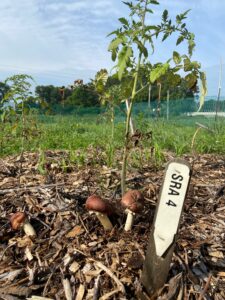
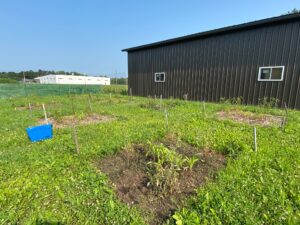
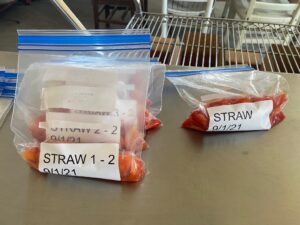
In spring 2021, we re-planted tomato plants and monitored the plots throughout the second growing season. We took yield from all harvests and recorded labor hours for economic evaluation. Due to covid, we were unable to host field days, so we filmed footage of plot assessments and created videos to promote the research and share progress. Soil and plant tissue samples were collected from all plots at the end of the 2021 growing season for future testing.
In 2022, we planted two rows of black bean plants in each of the 15 plots. One row of bean plants was inoculated with arbuscular mycorrhizal fungi (AMF+) while the other received a mock inoculum without AMF fungi in response to research indicating the black bean plants are better at uptaking ergothioneine and that AM fungi may be responsible for the transport into the crop plant. Root samples were collected to confirm AMF establishment, leaves and beans were harvested to quantify crop nutrition and ergothioneine content. Data was recorded on data sheets and compiled into Excel. Statistical analysis were performed using Systat and interpretation of results will be discussed with supporting professionals. Complete results will be reported in the final submission.
Soil Results:
Initial soil tests examining soil biology (Total fungi, fungal activity, bacterial biomass, etc) from each of the five replicates indicate no statistical differences between treatments. These data served as the baseline for comparison to soil tests taken at the end of the two year project in order to determine if our treatments impacted soil biology.
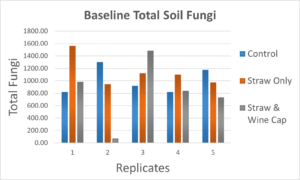
Final soil tests showed few significant measurable differences in soil parameters among treatments. Total soil bacteria was nearly statistically different with highest populations in SRA plots (5.5ug/g), followed by control (2.8ug/g) and straw plots (2.3ug/g) using one-way ANOVA (F(2,12) = [3.19], p = 0.08).
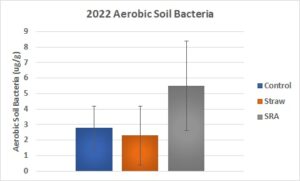
We used data from 2020 as the baseline to compare soil data from 2022 using repeated measures ANOVA. In general, there was a decrease in soil microbial populations and activity from 2020 to 2022. Total soil bacteria decreased significantly in all treatments from 2020 to 2022 (F(1,24) = [16.92], p < 0.001).
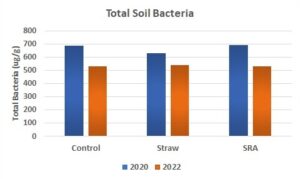
We also noticed an overall decrease in total soil fungi from 2020 to 2022. The mean total soil fungi increased in the Wine Cap mushroom (SRA) treatment plots, but the change was not statistically significant.

Organic Matter Decomposition:
We measured the bed depth, or remaining mulch material, as a measure of the decomposition rate. We performed a one-way ANOVA comparing the effect of the Wine Cap Mushroom on Bed Depth. Bed depth was significantly different between treatments just 3 months after plot establishment (F(1,8) = [36.96], p < 0.001), where the Wine Cap reduced average bed depth to 11.6cm and Straw plots remained at 15.2cm. Bed depth was measured the second season (August 2021) and remained significantly different between treatments (F(1,8) = [11.61], p < 0.01), where Wine Cap and Straw plots measured 8.82cm and 11.54cm, respectively. Plots with the Wine Cap Mushroom (SRA) were shallower in both instances indicating that the Wine Cap mushroom breaks down the organic mulch layer more quickly than native microorganisms. By 2022, no significant differences remained between treatments indicating that the effect of the Wine Cap mushroom is most influential in the first two years of treatment.
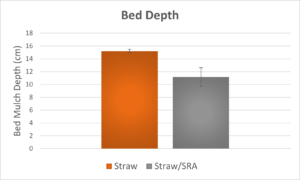
We also measured bed temperature as an indicator of microbial decomposition and found significant differences between the Straw and SRA treatments (F(1,8) = [6.93], p = 0.03). Beds with Wine Cap mushrooms were 2.1°F warmer than mulch only beds indicating more biological activity, likely responsible for increased decomposition.
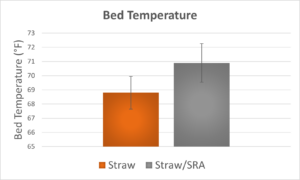
Plant Health & Productivity
Tomato plants were planted into treatment plots (2 plants/plot) in 2020 and 2021. Plant overall health was visually evaluated (greenness, size, fullness, presence of disease) and rated on a scale from 0 = dead to 10 = healthiest. A one-way ANOVA evaluating treatment effect on tomato plant health from August 2021 data, revealed that plants in plots with Wine Cap mushrooms were the healthiest with an average health rating of 8.0 compared to 4.2 in control plots and 4.3 in straw mulch plots (F(2,26) = [8.37], p = 0.001).
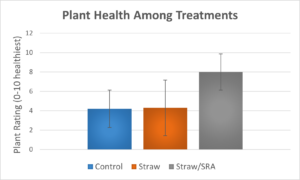
Tomato plant disease was also rated on a scale from 0 (no disease) to 10 (dead from disease). A one-way ANOVA evaluating treatment effect on tomato plant disease severity from August 2021 data, revealed that plants in plots in control plots suffered from more severe disease with an average rating of 6.1 compared to 3.35 in straw mulch plots and 3.15 in least affected SRA plots (F(2,57) = [30.70], p < 0.001).
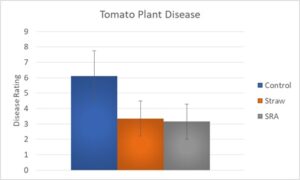
All tomatoes were harvested from each plot at peak ripeness. Yield was recorded and subsamples from each plot were frozen at -80'C for Ergothioneine testing. Overall, tomato plants in plots with the Wine Cap mushroom (SRA) yielded more tomatoes (6.85lbs) compared to straw mulch only plots (4.59lbs) and control plots (2.38lbs).
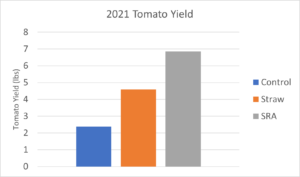
In 2021, we planted a row of sweet corn into each plot (n=15) and measured overall height of the plants. One-way ANOVA results indicate that the corn plants in the Wine Cap mushroom plots were significantly taller (39.9") than plants in Straw (33.9") and Control (34.9") plots (F(2,112) = [12.47], p < 0.001) during the mid season measurements in August.
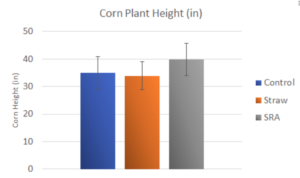
We elected to plant black beans in the third year of the study (2022) based on new data indicating that tomatoes are challenging to sample for ergothioneine. In each plot, there were two rows of black bean plants - one inoculated with arbuscular mycorrhizal fungi (AMF+) and the other with a mock inoculum without mycorrhizal fungi. Plant tissue and root samples were sent in to confirm successful AMF establishment during the seedling stage and shortly after field planting. Black beans were harvested at the end of the season when the pods were fully developed. Black Bean yield data between treatments was not statistically significant. Overall yields were low - likely due to several variables. 2022 was a dry summer and plots were without a good irrigation system. Many plots experienced extensive leaf tissue damage by Japanese Beetles (Popillia japonica) and rabbit damage resulted in a total loss of plants in several treatments. We also noted moderate chlorosis visible in the control plot plants several weeks after planting, eventually chlorosis was noticeable in all treatments across the experimental field. We elected not to fertilize in order to more accurately measure any impacts of our treatments, however, the black beans suffered resulting in low yields.
Weed Suppression
Weed suppression was estimated for each plot from 0% (no weed suppression) - 100% (total suppression, no weeds present). Control plots without any mulch had 0% weed suppression as expected, whereas the Straw (95%) and SRA (92%) plots had significantly higher weed suppression ability, even after 1 year establishment (F(2,12) = [2187.25], p <0.001).

Ergothioneine
The Wine Cap mushroom (Stropharia rugoso-annulata, SRA) has not been previously tested for ergothioneine (ERGO) to the author's knowledge. We sent in freeze-dried mushroom samples of Wine Cap and Almond Agaricus to Heartland Assays for ergothioneine analysis via HPLC. Both mushroom species were found to contain relatively high levels of ergothioneine, indicating the potential of these cultivars to be used to enhance ERGO content in soils and food crops.
Ergothioneine Content in mushroom samples:
Wine Cap: 1.67 mg/g
Almond Agaricus: 1.16 mg/g
We were not able to get the Ergothioneine uptake into black beans quantified by the time this report was due. Those results are awaiting analysis and will be uploaded as soon as they are available. We hypothesize that the ergothioneine uptake will be highest in beans growth within the Wine Cap treatment plots, and highest in plants inoculated with AMF fungi prior to planting.
Project Conclusions
Over the three years of this study, we were able to confirm the findings of our previous grant FNC17-1070. We consistently measured larger, healthier crop plants (Tomato, corn, and black bean) grown in plots with the commonly cultivated Wine Cap Mushroom (Stropharia rugoso-annulata). Furthermore, tomato plants grown in plots with Wine Cap had higher yields, on average, than the straw and control plots. The addition of mulch to the soil surface can increase soil moisture retention, aid in building the soil, suppress weeds, and act as a protectant from soil-borne pathogens for plants. We were able to measure these benefits by comparing control plots to the treatment plots that received mulch. Furthermore, we were able to demonstrate that the addition of Wine Cap not only speeds up the decomposition of raw organic mulch materials, but the actively growing fungi also increase bed temperature. We continued to struggle with how to appropriately measure any soil changes in response to our treatments. Given the high degree of spatial-temporal variation in many soils, we increased our number of replicates as well as number of soil cores per plot from the previous study. Despite these attempts, there was still a high degree of variability between our 5 replicate plots in each treatment. It is possible that the time frame of this study is insufficient to measure changes in soil parameters. Lastly, 2022 was a much drier season than 2020 and this likely attributed to the significant decline in overall soil biological activity from 2020 to 2022.
These results, our experimental work, and experiences have been frequently shared through the Field and Forest website, video content, and direct communications with farmers. We have noticed a significant increase in farmer interest in using cultivated fungi to improve soil health and many who have shared their own experiences and observations.
Educational & Outreach Activities
Participation summary:
We had to cancel our field day events in 2020 and 2021 due to COVID, so we really focused on digitally promoting our research and creating videos that we could share and build upon. We produced the first two video installments and will continue to produce more as our research project enters its second and final year. We intend to host in person events in 2021 if we are able, but will also be doing live digital events or online workshops to reach a larger audience and provide a more interactive experience.
Wine Cap Research SARE Grant Series: Part 1. Video released July 9th, 2020, received 1,233 Views on YouTube: https://www.youtube.com/watch?v=BVNx6qgz5bE&feature=emb_logo
Wine Cap Research SARE Grant Series Part II: Soil Tests, Data Measurements and Plot Maintenance. Video released September 3rd, 2020, received 600 views on YouTube: https://www.youtube.com/watch?v=yezl-x-hORI
We've promoted the research we are doing and shared these videos through our Facebook page (2,705 people reached from 3 posts), our webpage (https://www.fieldforest.net/research), and Field and Forest Products' newsletters to thousands of growers.
August 2020 Newsletter: https://mailchi.mp/fieldforest.net/august-2020-newsletter-080620?fbclid=IwAR2jucb9QYQfi39xt_w_bRfNAqgD8mDU73_n378Coz5o6vE8q3IA-phuC-0
September 2020 Newsletter: https://mailchi.mp/fieldforest.net/september-2020-newsletter-091720?fbclid=IwAR1V825mjy-Slxjp3oyDyi1a3OmVLdhtF7Ccf2AvIoX8NKaV3b2ZnweCIYo
Wine Cap Research SARE grant Series Part III: Year 1 Plot Observations. Video released April 2, 2021, received 1,142 views on YouTube.
Wine Cap Research SARE grant Series Part IV: Plot progression and data collection. Video released September 10, 2021, received 395 views on YouTube.
Learning Outcomes
We continue to observe and measure benefits of polyculturing fungi and plant crops together and share that excitement and potential to other farmers. Research projects such as this one are an excellent opportunity to apply theoretically knowledge and test for practical application. This project has been a powerful learning opportunity. In our experience through this and previous research efforts, we've learned some of the complications of soil sampling, how to attempt to account for high spatial-temporal variability in soils, and the implications of unpredictable but highly influential weather differences across seasons and years on quantitative data. In response to some of these challenges and through a partnership with another researcher, we set up a pilot study with another mushroom species, Almond Agaricus (Agaricus subrufescens), that can be easily cultivated and applied to more controlled, ex-situ, experiments. By applying the concepts of this research project to this new mushroom cultivar, we are confident that we will be able to address and limit some of the extraneous variables influencing our ability to accurately measure the impacts of cultivated fungi on crop plants and soil.
Project Outcomes
We evaluated the potential benefits of Wine Cap mushroom cultivation on Tomato crops, however, it would be beneficial to examine the impact mushroom cultivation can have on other agricultural crops. In addition, this project and growing scale is gardener to small farm and labor was done manually. We recommend examining the potential to scale up mushroom cultivation to benefit large agriculture where machinery is used to plant, fields are used exhaustively, crop rotation is limited, and there is increased pressure on the soil.
